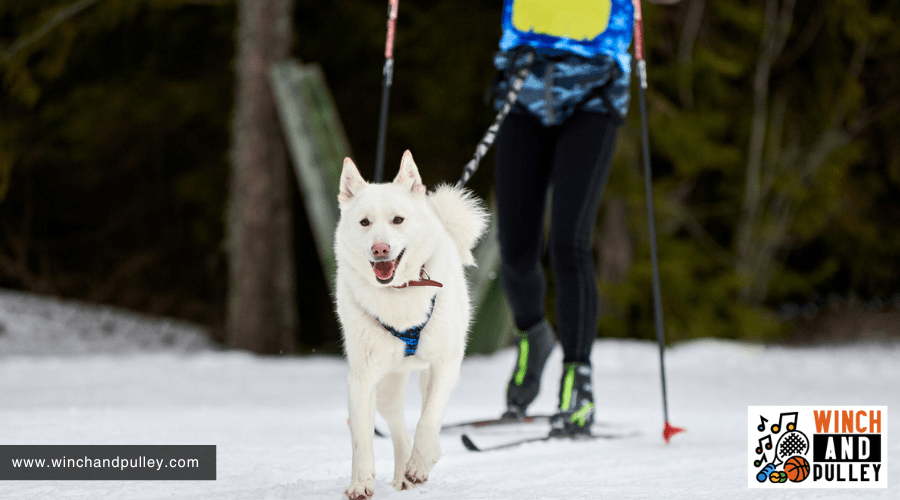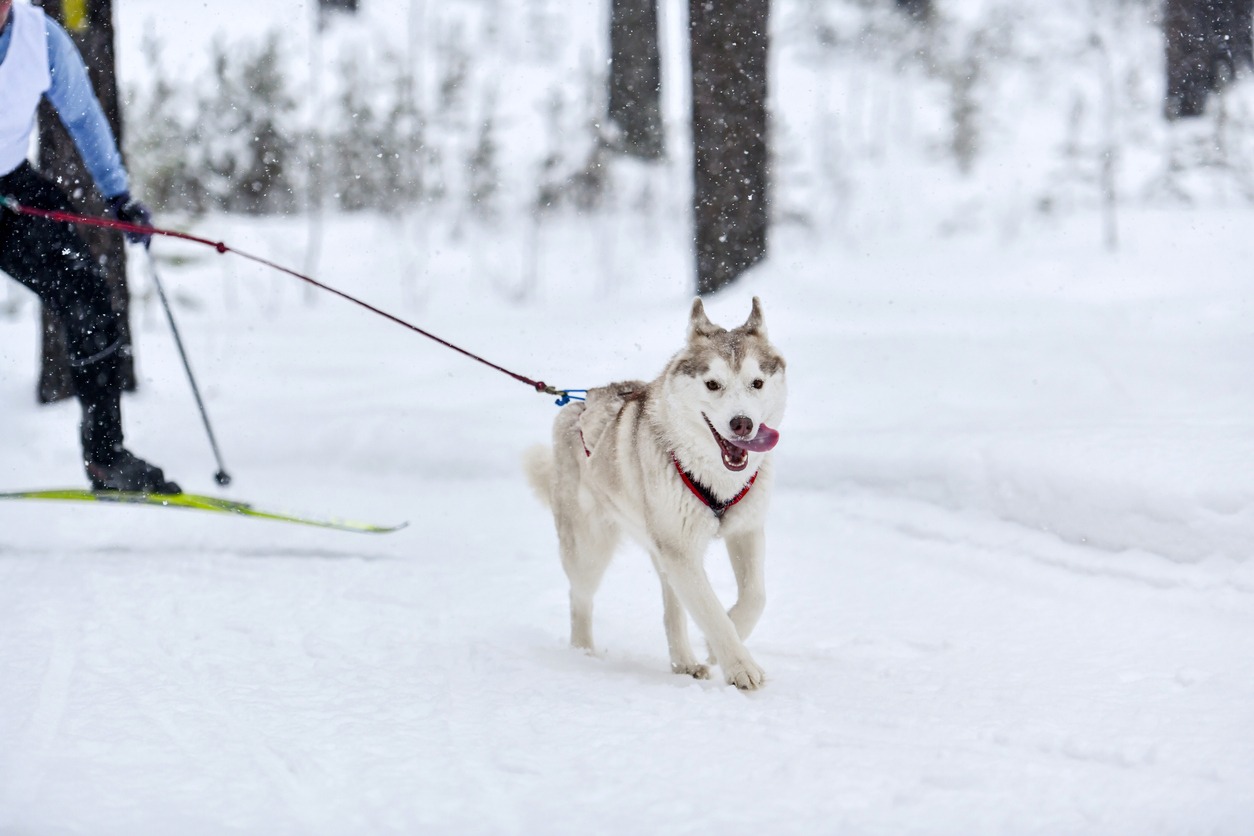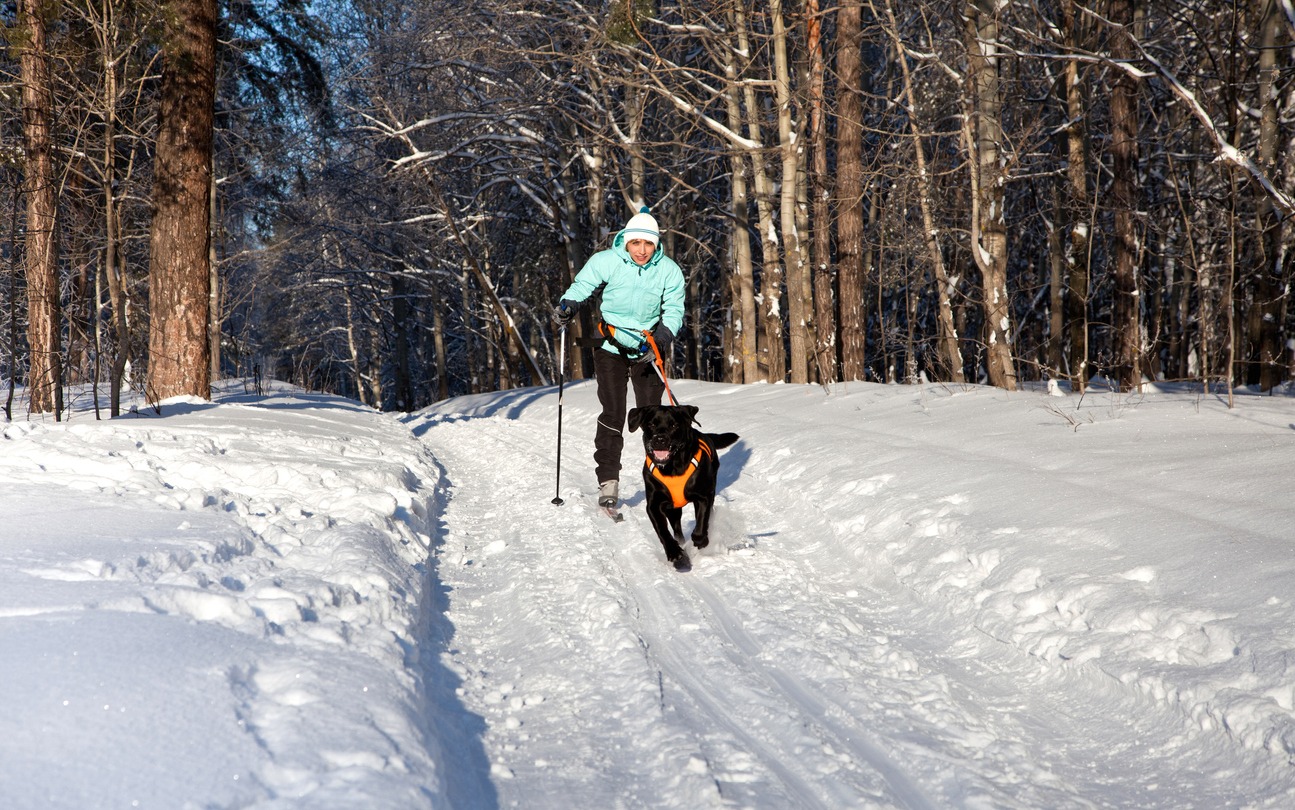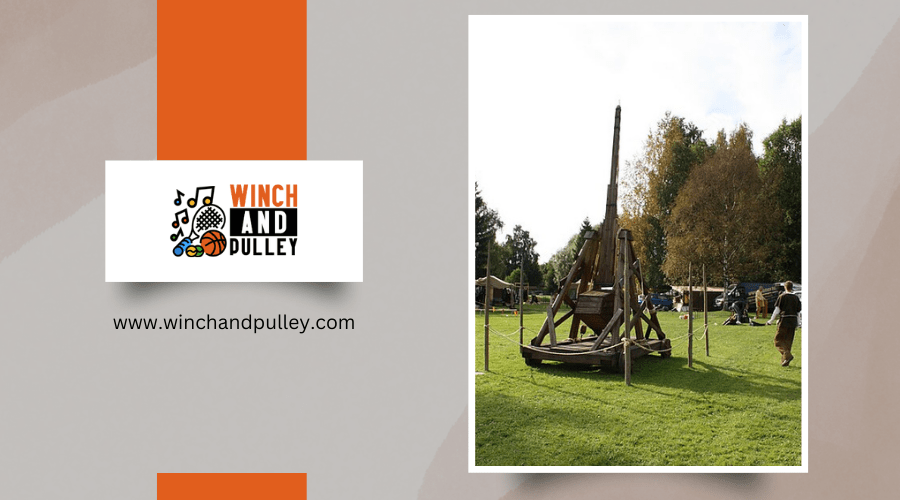Skijoring: Being Pulled on Skis by Dogs or Horses

Imagine gliding across snowy landscapes, propelled by the strength and coordination of dogs or a horse. Skijoring, a sport with deep roots in Scandinavian culture, offers this unique winter experience.
Whether you're drawn to the teamwork required with dogs or the power of an equestrian partner, skijoring provides an exhilarating way to enjoy winter. But what does it take to get started, and how do you ensure safety and enjoyment for both you and your animal partners?
Let's explore the fundamentals you need to know before hitting the trails.
Key Takeaways
- Skijoring combines the thrill of skiing with the collaborative elements of mushing or equestrian sports, where skiers are pulled by either dogs or horses.
- In dog skijoring, typically 1-3 dogs pull a skier along snowy trails. This activity uses specialized harnesses and lines for effective control and communication.
- Equestrian skijoring involves a skijoring belt, horse harness, and safety gear, with the horse pulling the skier through complex courses.
- Competitions for both dog and equestrian skijoring test participants' skills, endurance, and teamwork, drawing enthusiasts to snowy locales.
- Adherence to safety protocols, proper training, and regular equipment checks are essential for a safe and enjoyable skijoring experience.
History of Skijoring
Skijoring originated with the Sami people in Scandinavia, who used reindeer to traverse snowy terrains. This unique mode of transportation showcased the Sami's ingenuity in harnessing reindeer for travel.
Over time, skijoring evolved beyond reindeer and Scandinavia. By 1915, equine skijoring—where skiers are pulled by horses—gained popularity in Switzerland, France, and Lake Placid, introducing a thrilling new dimension to the sport.
The international appeal of skijoring grew, and in 1928, it was featured as an exhibition sport at the Winter Olympics in St. Moritz, Switzerland. This event significantly bolstered the sport's visibility and allure. The spectacle of skiers being pulled by horses through snowy landscapes at high speeds captivated audiences.
Equine skijoring continued to be popular in Europe, especially in France and Switzerland, becoming a cherished winter activity.
These early adaptations paved the way for the diverse variations of skijoring seen today, including those involving motorcycles and automobiles. The transformation of skijoring from a Sami tradition to an Olympic exhibition underscores its enduring and dynamic appeal.
Dog Skijoring Basics

Dog skijoring combines the thrill of skiing with the teamwork of mushing, offering an exhilarating experience for both you and your canine companions. Typically, skijoring involves 1-3 dogs pulling you along snowy trails. Whether for recreational enjoyment or competitive pursuits, skijoring provides a unique way to bond with your dogs and appreciate the winter landscape.
To begin skijoring, you'll need some essential equipment. Both you and your dogs require specialized harnesses. You'll wear a skijoring harness designed to distribute the pulling force evenly, while your dogs will wear sled dog harnesses for their comfort and efficiency. A bungee line usually connects you to your dogs, absorbing shocks and ensuring smooth motion.
While many skijorers participate recreationally, there's also a competitive aspect. Races, ranging from 5 to 20 kilometers, are organized by bodies such as the International Sled Dog Racing Association (ISDRA) and the International Federation of Sleddog Sports (IFSS). These races test the speed, endurance, and teamwork between you and your dogs, making skijoring an exciting and challenging winter sport.
Dog Skijoring Competitions
Dog skijoring competitions feature a variety of formats, each designed to test different skills and endurance levels. Successful participation requires extensive training and preparation, emphasizing both your fitness and the dogs' conditioning. Events range from short 5-kilometer sprints to challenging long-distance races, all demanding a well-coordinated team effort.
Competitive Race Formats

Competitive dog skijoring features a variety of race formats that test both speed and endurance, with distances ranging from short 5-kilometer sprints to challenging 20-kilometer races. These events are held in snowy regions and attract skiers and dog enthusiasts alike. Organizations such as ISDRA, ESDRA, and IFSS ensure that these races maintain standardization and prioritize safety, creating a fair and secure environment for all participants.
In these races, you and your canine partner must work in perfect harmony. Effective communication is essential, as you'll use specific commands to guide your dog through the course. The complexity of the terrain and the length of the race demand not only physical stamina but also strategic coordination between you and your dog.
Long-distance races, such as the Kalevala in Russia and the River Runner 120 in Canada, present a true test of endurance and skill. These events challenge participants to maintain a consistent pace and navigate various obstacles. Whether you're aiming for the speed of a sprint or the stamina of a marathon, dog skijoring competitions offer an exhilarating test of teamwork and athleticism.
Training and Preparation
Preparing for dog skijoring competitions requires rigorous training to build both your and your dog's coordination and endurance. Fostering teamwork ensures smooth communication on the trail. Begin by mastering basic commands like 'gee' for right turns and 'haw' for left turns, essential for effective course navigation.
Your dog's physical and mental preparation is crucial. Gradually increase the complexity and duration of training sessions to build endurance and speed. Ensure your dog is comfortable with various terrains and weather conditions. Regular practice enhances your dog's ability to understand and respond to your cues promptly.
Maintaining your physical fitness is equally important. Skijoring demands significant strength and stamina from both participants. Engage in cross-training activities like running and strength workouts to stay in top condition.
Dog Skijoring Equipment
When gearing up for skijoring, having the right equipment is crucial for both you and your dog. The key components include skijoring harnesses for you and sled dog harnesses for your dog. These harnesses are designed to distribute the pulling force evenly, ensuring comfort and preventing injury.
Connecting you and your dog are skijoring lines, which maintain control and communication during the activity. These lines are typically elastic, absorbing shocks and providing a smoother ride. Make sure your skis are hot waxed to reduce friction and maintain speed.
Training your dog with specific sledding commands is important. Commands like 'gee' for right and 'haw' for left help in steering and controlling speed. This training is especially crucial when passing other teams, a skill top skijoring teams excel at.
Investing in quality skijoring equipment and properly training your dog makes the experience safer and more enjoyable for both of you. So, gear up correctly and hit the snow with confidence, knowing you're well-prepared for the adventure ahead.
Dog Skijoring Techniques

Mastering dog skijoring requires a combination of physical fitness, effective communication, and synchronized teamwork between you and your dogs. As a skier, you'll use ski poles to assist with propulsion while your dogs pull you forward. Success hinges on the proper use of harnesses for both you and your dogs, ensuring a comfortable and efficient pull.
You should be proficient in either classic diagonal stride or skate skiing techniques, as these are the most effective for maintaining speed and stability. Your dogs need to wear sled dog harnesses designed for optimal pulling power and comfort. Training your dogs with specific commands is crucial for both competitive racing and safety. Commands for speed, direction, and passing other teams are essential.
A strong bond and clear communication between you and your dogs are crucial. Commands like 'hike' for go, 'gee' for right, and 'haw' for left should be practiced regularly. Coordinated movements and mutual understanding will lead to a smoother, more enjoyable experience. With the right techniques, you and your dogs can become a formidable skijoring team, ready to tackle any trail or race.
Equestrian Skijoring Overview
Preparing for equestrian skijoring requires the right equipment and adherence to safety protocols to ensure a secure and exhilarating experience for both the rider and the skier. Below, we outline the essential gear you'll need and best practices to maximize safety for all participants.
Equipment and Gear Essentials
Equipping yourself for equestrian skijoring involves securing specialized gear such as skijoring belts, horse harnesses, and skier harnesses. The right equipment ensures both safety and performance, whether you're practicing or competing. Skijoring belts connect you to the horse without restricting movement, while horse harnesses distribute the towing force evenly, ensuring the horse's comfort and control. Skier harnesses help maintain balance and stability as you're being pulled.
In equestrian skijoring, traditional skiing techniques are essential, so high-quality skiing gear is necessary. Premium skis and bindings significantly impact your performance. Helmets and protective gear are mandatory, especially in competitions where jumps and gates are part of the course. Competitions often feature different classes based on skill levels, making it crucial to have gear tailored to your experience.
Events are held in various locations, including the US, Europe, and the famous White Turf event in St. Moritz. Organizations such as Skijor International and Skijor USA promote the sport, with aspirations of reintroducing it to the Winter Olympics.
Training and Safety Tips
Ensuring safety and success in equestrian skijoring begins with comprehensive training for both the horse and the skier. The horse must be comfortable around skiers and in fast-paced environments. Start with basic training to familiarize your horse with the unique demands of skijoring. Gradually introduce the skier and equipment, ensuring the horse remains calm and responsive.
For safety, perform regular equipment checks before every run. Inspect the harness, ropes, and ski gear for any signs of wear and tear. Course inspections are equally important; ensure the track is hazard-free and well-marked.
Clear communication between the rider and skier is vital. Establish signals or commands to coordinate movements, especially when navigating jumps, turns, and gates.
As a skier, mastering balance techniques is crucial. Practice maintaining a low center of gravity and using your knees to absorb shocks. This will help you maintain control and agility over varied terrain. Coordination between the horse, rider, and skier is essential for smooth maneuvers. Spend ample time training together to sync movements and build trust. Rigorous training enhances both performance and safety, making your skijoring experience more enjoyable and successful.
Equestrian Skijoring Gear
For equestrian skijoring, you'll need specialized equipment such as a skijoring belt, a horse harness, and a connecting line. The skijoring belt secures you to the horse, ensuring smooth coordination as you glide across the snow. The horse harness is crucial for evenly distributing the pulling effort across the horse's body, preventing injuries and optimizing performance.
Safety is paramount in this thrilling sport. A well-fitted skijoring belt and horse harness provide essential security, while the skijoring line connects you to your equine partner, ensuring a stable and controlled ride. Coordination between the skier and the horse is crucial, especially since reins or signaling devices aren't typically used.
Equestrian skijoring competitions offer different classes to accommodate varying skill levels and experience. Whether you're starting in the Novice class or competing in the Pro/Open class, the right gear is essential.
Here's a quick breakdown:
| Gear | Purpose | Importance |
|---|---|---|
| Skijoring Belt | Secure attachment | Ensures smooth coordination |
| Horse Harness | Evenly distributes pulling effort | Prevents injuries, optimizes performance |
| Skijoring Line | Connects skier to horse | Provides stability and control |
| Safety Equipment | Protects both skier and horse | Vital for injury prevention |
| Classes | Varies by skill level | Tailors experience and competition |
Proper gear not only enhances your safety but also significantly improves your performance in this exhilarating winter sport.
Equestrian Skijoring Venues
Equestrian skijoring enthusiasts can find thrilling events at various venues, ranging from local races to prestigious competitions in Idaho. These events exemplify the dynamic nature of equestrian skijoring, where speed and skill converge in extreme competitions. Professional skiers, pulled by experienced horses, navigate intricate courses filled with jumps and gates that test their agility and coordination.
Idaho hosts some of the most vibrant scenes in equestrian skijoring, attracting top-tier competitors and enthusiastic spectators. The level of expertise displayed is remarkable, with skiers maneuvering through challenging courses at high speeds. The horses, meticulously trained for these events, demonstrate incredible strength and responsiveness, making the races even more captivating.
Safety is a critical aspect of equestrian skijoring events. Organizers ensure that both skiers and horses are protected by implementing protocols that mitigate the risks associated with high-speed racing. Standard safety measures include helmets, protective gear, and well-maintained equipment to maintain a secure environment.
Equestrian skijoring offers a unique, adrenaline-filled winter sport experience. The combination of competitive settings, the power of horses, and the finesse of skiing make these events unforgettable for both participants and spectators.
Motorized Skijoring
When preparing for motorized skijoring, it's essential to prioritize proper equipment and safety gear. Selecting the appropriate vehicle—be it a snowmobile, motorcycle, or car—is crucial for a safe and exhilarating experience. Let's delve into the essential skijoring techniques to ensure a thrilling and safe adventure.
Equipment and Safety Gear
In motorized skijoring, reliable safety gear such as helmets, goggles, and protective clothing is essential to minimize injury risks. This gear protects you from potential falls and collisions. Skijoring lines in motorized skijoring are typically longer, ensuring a safe distance between you and the vehicle, whether it's a snowmobile or an ATV. These lines are robust and flexible, accommodating the dynamic nature of the sport.
Your skijoring belt should have sturdy attachment points to securely connect to the tow vehicle, ensuring the connection remains strong even during high-speed maneuvers. Proper maintenance and specific modifications to the vehicles are necessary for towing skiers efficiently and safely. Understanding how to use this equipment effectively is equally important.
Safety briefings and protocols are crucial before starting any motorized skijoring event. These briefings cover key safety practices and emergency procedures, ensuring everyone is informed. Following these protocols can greatly enhance your safety and enjoyment. The combination of proper equipment, well-maintained vehicles, and adherence to safety protocols makes motorized skijoring an exhilarating yet safe experience.
Choosing the Right Vehicle
When choosing a vehicle for motorized skijoring, consider the terrain and desired speed. Vehicles such as snowmobiles, motorcycles, and cars offer different levels of speed and maneuverability, each affecting your overall skijoring experience. Snowmobiles are often preferred for their ability to handle snow-covered terrain and achieve high speeds, making them ideal for those seeking an adrenaline rush.
Motorcycles can be used on less snowy, more compact surfaces, providing a unique twist on traditional skijoring. While less common, cars can also be adapted for this sport, though they require significant modifications to ensure safety and performance.
Regardless of your choice, prioritizing safety is crucial. Ensure your vehicle has the necessary modifications, such as enhanced traction and stability controls, to meet the specific demands of motorized skijoring.
While skijoring with dogs or horses offers a more traditional and natural experience, motorized skijoring provides enhanced excitement through increased speed and intensity. Selecting the right vehicle will enhance your experience and ensure your adventure is both thrilling and secure.
Skijoring Techniques Explained

Mastering motorized skijoring techniques requires an understanding of balance, steering, and reacting to the vehicle's speed and movements. Unlike traditional skijoring with dogs or horses, the motorized version demands greater control due to the higher speeds involved. Essential skills include maintaining a low center of gravity and using your body to steer.
In motorized skijoring, keep your knees slightly bent and your weight centered to absorb shocks and maintain stability. Lean slightly forward as the vehicle accelerates to counteract the pull. Steering is achieved by shifting your weight from side to side, similar to traditional skijoring.
Control is crucial, especially when maneuvering turns or navigating uneven terrain. Anticipate the vehicle's movements and adjust your position accordingly.
Historically, early motorized skijoring used motorcycles, and during WWII, the 10th Mountain Division utilized snow machines. Today, the sport involves snowmobiles and cars, offering fast-paced excitement that requires sharp reflexes and precise techniques. Master these skills to enjoy the exhilarating world of motorized skijoring.
Skijoring in Media
Skijoring has gained widespread attention across various media platforms, from blockbuster movies like 'The Call of the Wild' starring Harrison Ford to viral content on Instagram and TikTok. This exhilarating sport has captivated audiences, thanks to its frequent appearances in diverse media outlets.
YouTube channels and social media accounts are replete with skijoring adventures, where enthusiasts share their thrilling experiences with dogs and horses. These videos often go viral, drawing significant interest to the sport.
Competitions are another major highlight, extensively covered by outdoor sports magazines and TV shows. These events bring the excitement of skijoring to a broader audience, sparking interest and encouraging new participants. Local news stations and outdoor sports networks occasionally feature skijoring events and races, further enhancing the sport's visibility.
Whether you're watching a high-octane skijoring race on TV or scrolling through breathtaking skijoring clips on social media, it's evident that this unique sport has made a significant impact in the media landscape. No longer a niche activity, skijoring is becoming a mainstream outdoor adventure.
Frequently Asked Questions
What Is It Called When a Dog Pulls You on Skis?
When a dog pulls you on skis, it's called skijoring. You'll need a skijoring harness for yourself and sled dog harnesses for your dogs. This thrilling, competitive sport requires teamwork and coordination.
Is Skijoring Safe for Horses?
Yes, skijoring can be safe for horses if the right equipment is used, guidelines are followed, and proper training is conducted. Skilled riders and skiers are crucial, and veterinarians often monitor the horses' health during events to ensure their well-being.
Can a Dog Pull You on Skis?
Yes, a dog can pull you on skis. This activity, known as skijoring, involves one to three dogs pulling you over snowy terrain. Both you and the dogs wear specialized harnesses to ensure safety and enjoyment for all participants.
What Breeds of Dogs Are Involved in Skijoring?
Athletic breeds like Pointers and Huskies excel in skijoring. Golden Retrievers, Labradors, and various cross-breeds also participate effectively. Dogs under 40 pounds are rare due to the sport's demands for strength and endurance.
Conclusion
You've now got a glimpse into the exhilarating world of skijoring. Whether you're being pulled by enthusiastic dogs or a powerful horse, skijoring offers a unique blend of adrenaline and teamwork.
It's all about the bond between you and your animals, the right gear, and mastering the techniques. So, why not strap on your skis and give it a try? You might just find your new favorite winter adventure. Happy skijoring!


